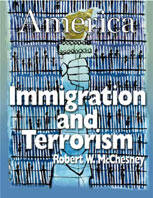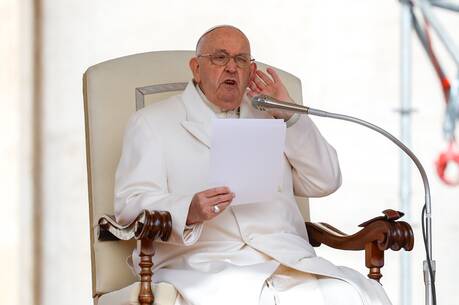The monstrous terrorist attacks of Sept. 11 have prodded the nation to reexamine itself. As America races to combat agents of global terrorism, particularly fundamentalist Islamic extremists, decision makers should proceed prudently so as to build the requisite broad coalition at home and abroad. A key homeland front, however, will be the many federal detention centers and local jails where noncitizens are held by the Immigration and Naturalization Service. The scope and terms of such detention are one of the sticking points in the antiterrorism legislation before Congress. Attorney General John Ashcroft favors broad powers to detain indefinitely and remove people from the United States, while civil liberties advocates on both sides of the aisle urge a more calibrated approach.
The audacity and carnage of the attacks are unprecedented, but we have been here before. Five years ago last month, America decided to go after terrorists by clamping down on immigrants and asylum-seekers. On Sept. 30, 1996, Congress passed the Illegal Immigration Reform and Immigrant Responsibility Act (IIRIRA), which subsequently spawned the nation’s fastest growing segment of the incarcerated population and led to record levels of deportation. There are important lessons to be learned from this history.
The Origins of the Illegal Immigration Reform Act
In the early 1990’s the U.S. economy had been stagnant. As economic indicators improved, however, the nation was shocked by a series of highly publicized terrorist crimes and incidents of border violation. On Jan. 25, 1993, a lone gunman ambushed motorists waiting at a red light outside the main entrance to the Central Intelligence Agency headquarters in Langley, Va. Two C.I.A. employees were killed, and three other people were wounded as they sat innocently in their cars. The following month a 28-year-old Pakistani immigrant by the name of Mir Aimal Kansi was charged with capital murder, subsequently found guilty and sentenced to death. As it turned out, he had come to the United States in March of 1991 on a business visa and eventually was issued a work permit. He perpetrated the terrible crime while awaiting disposition of his application for political asylum.
One month after the C.I.A. murders, an explosion rocked the World Trade Center in New York City, killing six people, wounding more than a thousand and sowing widespread fear. The following year, four Muslim fundamentalists were convicted of the crime. Each was sentenced to 240 years in prison. One had applied for political asylum, while another perpetrator had overstayed a student visa.
Still later in 1993, an old cargo steamer ran aground on a sandbar in the surf off New York City. The Golden Venture dumped her human cargo of 286 undocumented Chinese into the water. They swam the last few hundred yards to shore, then were arrested and detained. The Golden Venture quickly became the national news obsession of the day. Every television station in the country played and replayed scenes of what some tabloids described as a sea invasion of illegals. An already nervous public mainstream was now confronted with stark images of drenched Chinese nationals huddling under blankets on a windy New York beach, staring in confusion at the television cameras.
After three major incidents within six months, unscrupulous elements of the press found increasing profit in sensationalizing a story of immigrant hordes and terrorists breaching permeable borders to attack the fabric of American society. The immigration and criminal terrorist story lines blurred and became conflated. Popular discourse was virulent and fearful, and politicians took notice. The solution seemed all too obvious: close the borders to illegals and imprison or deport those already here.
Perhaps the most infamous event of this period occurred on April 19, 1995, when a Ryder truck parked outside the Murrah Federal Building in Oklahoma City exploded. The potent mix of fertilizer and fuel oil blew half the nine-story building into oblivion, killing 168 innocent people, including 19 children, and injuring another 500. According to initial press reports, Middle-Easterners were reportedly seen in the vicinity of the crime and were initially regarded as possible suspects. Two days after the blast, however, a Caucasian U.S. military veteran, Timothy McVeigh, was picked up and subsequently convicted of the heinous capital crime.
Legislative reaction to the sluggish economy and high-profile crimes and incidents had begun at the state level. In November of 1994 California passed Proposition 187, which placed onerous restrictions on legal and illegal immigrants. The courts subsequently overturned the initiative, but its popular political resonance remained potent.
In Washington, the newly elected 104th Congress saw a hot-button issue. After 40 years in the minority, Newt Gingrich had led the Republican Party to power in 1994. Citing polls that showed more than 70 percent of Americans wanted tighter restrictions placed on immigration, crime and terrorism, Congressional Republicans promised strict, tough-on-crime policy solutions as part of their Contract With America.
Mr. Gingrich interpreted Proposition 187 as the expression of a national public consensus on immigration. Even liberal Democrats were getting on the bandwagon. To maximize the political momentum after Oklahoma City, the Immigration Reform Act and a related bill, the Anti-Terrorism and Effective Death Penalty Act, were considered simultaneously. The latter, also enacted in 1996, suspended several traditional constitutional rights that had previously been granted to noncitizens. The juxtaposition of these two laws reflected the press and pundit sound bites, which loosely associated immigrants with terrorists and criminals.
President Bill Clinton, facing re-election and reading the same polls as the Republicans, signed IIRIRA on Sept. 30. Though a dubious product of the Republican Congress, it arguably represented the bipartisan national political consensus of the mid-1990’s. This uncritical association of immigrants with terrorists remains today the most troubling aspect of the national conversation on how to respond to the tragic events of Sept. 11 and can lead only to tragic social consequences and misguided governmental decisions.
Assessing the 1996 Legislation
The result of such loose thinking has a human face. The I.N.S. now holds over 20,000 noncitizens in detention every daymore than three times the 1996 numberunder the legislated system of mandatory detention. The average length of incarceration is relatively short because many are deported rapidly, but a significant percentage are held for over a year. More than 200,000 are detained annually, at a cost of $1 billion. A large number of those deported hold green cards as legal permanent residents, and can demonstrate significant equities in the community as job holders and property owners. One critic has called the 1996 laws the most extreme punitive outbreak of civil-liberties xenophobia since the Japanese internment camps of World War II.
The I.N.S. annually detains an additional 5,000 unaccompanied minors. None receives the celebrity attention afforded the Cuban boy and press darling, Elián González. Many are placed in isolated juvenile detention centers alongside U.S.-citizen minors with criminal histories, though most children under I.N.S. jurisdiction do not come from such a background. The trauma can be severe.
The 1996 laws provide a variety of strong tools by which to fight terrorism, and some now need to be further strengthened. But churches, community groups and civil liberties proponents have concluded that the 1996 legislation was indiscriminate in the wide net it cast. Both IIRIRA and the antiterrorism bill are blunt instruments that continue to punish many immigrants and their citizen families who have nothing to do with terrorism.
Last June, two Supreme Court decisions served notice that the judiciary, too, is concerned about excesses in the 1996 legislation. Both were favorable to the rights of detained immigrants, specifically to those of so-called criminal aliens: typically legal permanent residents who have been in the United States a long time. The issue is that these people were never naturalized and were convicted of a crimeoften a relatively minor, nonviolent offense for which they served their time. Some never served any time at all in prison because their sentences were suspended. Many are married to citizen spouses and have citizen children. Immigrant advocates argue that criminal aliens are neither. But thousands have been deported, and thousands more remain in detention facing deportation.
The Supreme Court was particularly troubled about the practice of indefinite detention and the lack of access for detainees to judicial review. Last summer’s decisions put Congress and the administration on notice that any new detention policies and procedures for noncitizens must pass constitutional muster.
In the present debate over new antiterrorist legislation, Congress seems determined not to repeat the mistakes it made in 1996. The ranking member of the House Judiciary Committee, Representative John Conyers, Democrat of Michigan, has addressed the issue squarely: Legislation that began in good faith as an effort to fine-tune our anti-terrorism laws turned into a legislative race to the bottom.... I sat through the hearings on this legislation and did not hear a single shred of evidence that proved that a single terrorist act could be prevented...by denying immigrants their due process rights. Senator Patrick Leahy, Democrat of Vermont, chairman of the Senate Judiciary Committee, noted in a recent interview with The Los Angeles Times that the nation must deport people who are intent on harming the United States, and that may require amending our immigration laws. He warned, however, that we should not brand legal permanent residents as terrorists and detain them indefinitely without giving them the chance to clear their names before a court.
Securing the Detention Front
No one should doubt that the nation faces a dire emergency and that other terrorist incidents may occur. It is also clear that there are many holes in U.S. immigration policy. In the wake of the appalling events of Sept. 11, noncitizen detention will become further institutionalized. Can this be done in a way that is compatible with the best American and ethical values? To fight justly it will be essential at home, as abroad, to target the enemy and not innocent victims, and to do so as humanely as possible. The federal government should address two areas expeditiously.
First, the federal government must provide better oversight for the system it inaugurated in 1996. There are nearly 300 facilities throughout the country housing immigrants and asylum-seekers. City and county jails profit handsomely from such federal contracts. The number of detainees will presumably grow in the near future. Immigrant advocates have complained that there is no adequate I.N.S. system of regulation and evaluation to govern the disposition of this population, despite the availability of a good working model at the federal Bureau of Prisons. This is a recipe for religious bigotry, shameful abuse and denial of basic human rights.
The I.N.S. has shown itself willing to listen. After an extensive dialogue with the American Bar Association and other nongovernmental partners, the agency recently began implementing a set of minimum standards for every facility holding noncitizen detainees under the 1996 legislation. The plan is to monitor and inspect all such facilities by the end of 2002. Unfortunately, the standards are not legally enforceable, and are only as useful as their implementation allows them to be. Presently the I.N.S. detention system relies on local self-reporting from the facilities themselves. When the agency asked for funding for up to 80 new inspectors to better monitor and enforce the standards from Washington, the Office of Management and Budget opposed the request.
Second, the I.N.S. must establish and integrate salaried chaplains into the system. Groundwork has been laid through the Jesuit Refugee Service’s Immigration Detention Program, a national Jesuit ministry that has made its personnel and expertise available to jump-start solutions. Working from the ground up at facilities in El Paso, Los Angeles and New York/New Jersey and coordinated through its national office in Washington, J.R.S. has served thousands of detainees and developed positive working relationships with local and national I.N.S. officials.
But the government has been woefully slow to extend systematically to noncitizen detainees the same level of religious care it requires for federal prisoners who are citizens. Together with an interfaith coalition in Washington, the J.R.S. national office has argued that the I.N.S. should establish salaried chaplaincies in its major facilities and integrate them into daily administration. Senior I.N.S. officials in Washington report that they have in fact requested funding for such a national chaplaincy program, but that the response has been negative.
The federal government should act quickly to institutionalize chaplaincy services, based on the successful federal Bureau of Prisons model. Incidents of religious bigotry toward Muslims abound, particularly in the local jails and county facilities where the I.N.S. houses the majority of noncitizen detainees.
Last fall, J.R.S. encountered a particularly troubling incident. When a 17-year-old Muslim from a south Asian country was detained in a Los Angeles County Probation facility, J.R.S./Los Angeles Minors Coordinator Alice Linsmeier began to assist him. She found volunteers who spoke Rajiv’s language and eventually a Muslim religious volunteer to minister to him. The youth spoke openly about his Muslim faith and interacted well with staff and other detainees. After several months in Los Angeles, however, the I.N.S. moved Rajiv to a remote county juvenile facility several hours’ travel distance to the north. There he experienced religious, linguistic and cultural isolation. In collaboration with the local Catholic diocese, Ms. Linsmeier attempted to arrange for pastoral visits by local Catholic sisters who spoke his language, but the facility chaplain, a fundamentalist Christian, objected.
J.R.S. then inquired about what was required to gain access to the juvenile facility, and was given two documents by the chaplain. Qualifications for a Volunteer in the Jail Ministry states at the outset: Must have experienced God’s saving grace and forgiving love through a personal relationship with Christ as his/her Savior. The second document, Instructions to Volunteer Applicant, reads in part: The applicant must keep in mind that this is an inter-denominational Christian ministry and our primary purpose is to lead individuals to a saving knowledge of Jesus Christ, instruct them in a knowledge of the Bible, and teach them how to live the Christian faith.
Only religious volunteers approved by the chaplain under these requirements were allowed regular access to the Muslim youth. Within months his condition deteriorated; he became suicidal, was placed in isolation and fitted with a straightjacket. Ms. Linsmeier was able to visit with him, accompanied by the translator from Los Angeles. Rajiv somewhat incoherently began to criticize Islam as wrong and said that he had been told the Koran was a piece of _____. He said he was afraid he was going to die and burn in hell. The facility social worker confirmed that the youth had developed conflicts of a religious nature.
Now, more than ever, the federal government should act decisively to institutionalize and monitor the freedom of religious expression of detained noncitizens. This reflects what is best about the national heritage. Furthermore, positive engagement with moderate American Muslims and Arabs may be crucial to the long-term defeat of Islamic terrorists and extremist ideologues. Stories of religious bigotry inside the walls may reinforce those who seek another crusade and undermine cooperation with law enforcement officials by potential allies. People like Rajiv have Muslim family and friends in the United States as well as their country of origin. The nation must get tougher on terrorism, but should also be smart and fair toward immigration.








